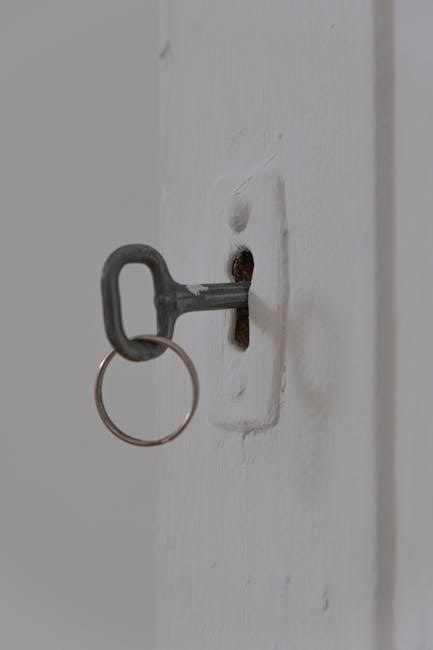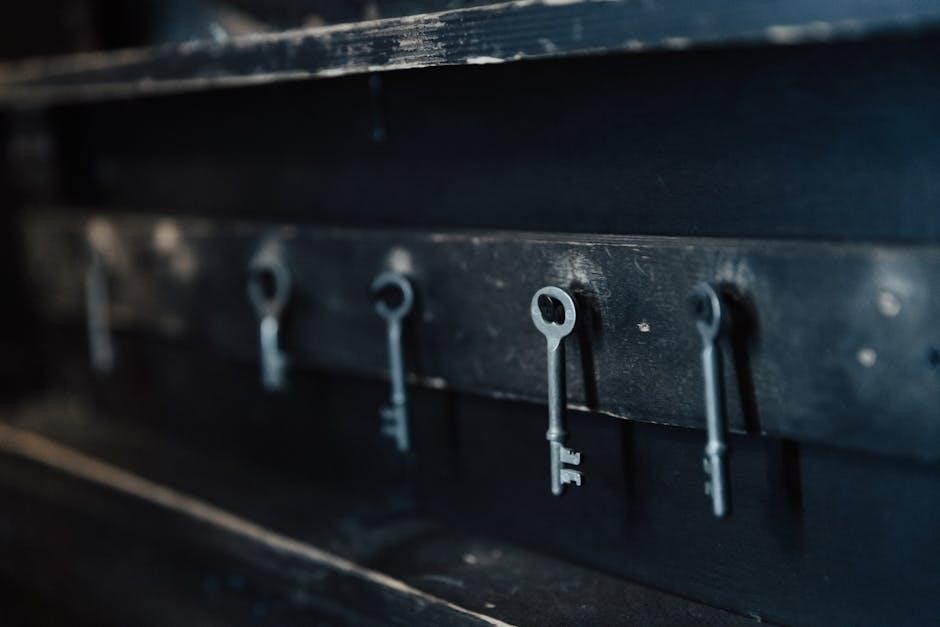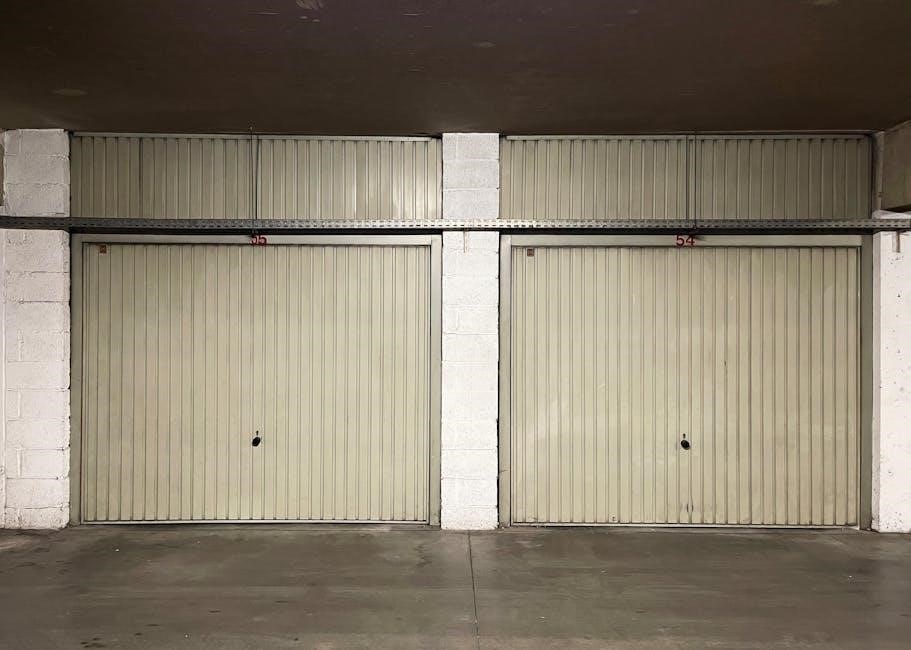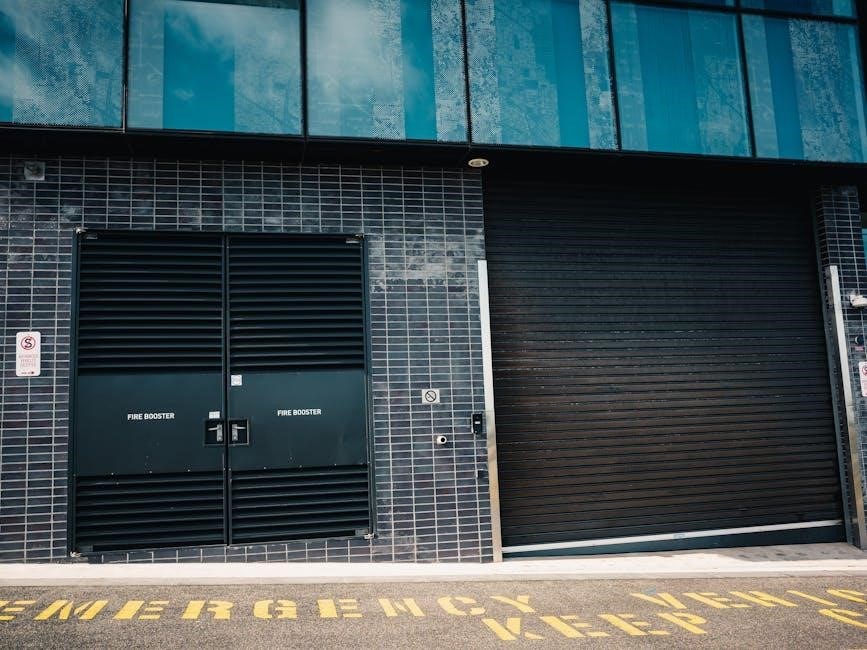how to manually lock a garage door

Manually locking a garage door enhances security and peace of mind. Use a vertical rod lock‚ which slides into the track‚ or install slide bolts at the bottom or side for added protection. For emergencies‚ C-clamps or vice grips on the track can temporarily secure the door.

Manual garage door locking is a practical and essential skill for homeowners seeking enhanced security and peace of mind. Whether dealing with a power outage‚ a malfunctioning opener‚ or simply wanting an extra layer of protection‚ knowing how to manually lock your garage door ensures your property remains secure. This method is particularly useful when automatic systems fail or when added safety measures are needed‚ such as during extended absences from home.
Manual locking mechanisms vary‚ from slide bolts to vertical rod locks‚ and even temporary solutions like C-clamps or vice grips on the track. These methods prevent unauthorized access and provide a reliable backup to automatic systems. Learning how to manually lock your garage door is straightforward and involves understanding the door’s structure and available locking options. By mastering this skill‚ you can ensure your garage—and everything inside it—remains safe and secure in any situation.
For garages without built-in locks‚ creative solutions like blocking the track or installing aftermarket locks can offer additional protection. This guide will walk you through the steps‚ tools‚ and tips needed to manually lock your garage door effectively‚ ensuring your home’s security is never compromised.

Preparing to Manually Lock Your Garage Door
Before manually locking your garage door‚ ensure the door is fully closed and secure. If your garage door has an automatic opener‚ disconnect it by pulling the red release cord‚ allowing the door to switch to manual mode. This step is crucial for ensuring the door can be locked properly without interference from the opener.
Check the door for any obstructions or alignment issues that could hinder the locking process. Clear the area around the door tracks and rollers to ensure smooth operation. If your door has a lock‚ inspect it for proper function. For doors without built-in locks‚ consider temporary solutions like C-clamps or slide bolts to secure it.
Gather necessary tools‚ such as a key for key-operated locks or a wrench for adjusting manual mechanisms. Familiarize yourself with the locking mechanism‚ whether it’s a vertical rod lock‚ slide bolt‚ or another type. Understanding how your door’s lock works will make the process faster and more efficient.
Lastly‚ ensure you have proper lighting to see the locking mechanism clearly. Preparation is key to manually locking your garage door effectively and ensuring your property’s security.

Manual Locking Mechanisms for Garage Doors
Manual locking mechanisms for garage doors provide an extra layer of security and can be installed or activated without relying on automation. One popular option is the vertical rod lock‚ which consists of a steel bar that slides into the door’s track‚ preventing it from opening. This mechanism is durable and effective against forced entry.
Another common mechanism is the slide bolt lock‚ which is typically installed at the bottom or side of the door. When engaged‚ the bolt extends into the track‚ securing the door in place. These locks can be key-operated or equipped with a manual handle‚ offering flexibility in use.
For added security‚ some homeowners opt for deadbolts specifically designed for garage doors. These locks require a key and provide a robust defense against unauthorized access. Additionally‚ temporary solutions like C-clamps or vice grips can be placed on the door’s track to block movement‚ offering a quick fix in emergencies.
Each mechanism has its advantages‚ and the choice depends on the door’s design and personal preference. Manual locks are a practical way to enhance garage security‚ especially when combined with other safety measures.
Securing a Garage Door Without a Built-In Lock

If your garage door lacks a built-in lock‚ there are still effective ways to secure it manually. One popular method is using C-clamps or vice grips on the door’s track‚ just above a roller. This creates a physical barrier that prevents the door from opening‚ even if someone tries to force it.
Another option is to install a slide lock‚ which is a spring-loaded bar that fits into one of the square openings in the track. When engaged‚ it blocks the door’s movement‚ providing a simple yet reliable security solution. These locks are easy to install and require no special tools.
For added protection‚ consider adding a manual slide bolt to the door. This involves attaching a bolt to the door and sliding it into a receiver on the frame or track. Key-operated slide bolts are also available‚ offering an extra layer of security.

These methods are cost-effective and easy to implement‚ ensuring your garage remains secure even without a built-in lock. Combining them with other security measures‚ like disabling the automatic opener or using a padlock‚ further enhances protection.
Emergency Locking Solutions
In emergency situations‚ such as a broken lock or no other access‚ securing your garage door quickly is essential. One effective solution is to use a temporary bar lock‚ which involves placing a sturdy bar across the door and securing it with brackets or clamps. This prevents the door from being opened forcefully.
Another emergency solution is to use zip ties or rope to bind the door to the track. Wrap the ties around the rollers and the track‚ creating tension that makes it difficult to lift the door. For added security‚ you can also use a padlock to secure the ties in place.
If the door is damaged or the lock is broken‚ consider using plywood to reinforce it. Cut a piece of plywood to fit over the damaged area and secure it with screws or nails. This provides a temporary barrier until a permanent repair can be made.
These emergency locking solutions are quick‚ cost-effective‚ and provide immediate security for your garage door. They are especially useful during power outages or when you’re away from home and need to ensure your valuables remain safe.
Additional Security Measures

Beyond manual locking‚ consider installing a deadbolt system for enhanced security. Deadbolts are difficult to force open‚ providing an extra layer of protection. Additionally‚ using a bar lock or slide bolt ensures the door remains secure even without a built-in lock.
Another effective measure is to reinforce the door with a metal frame or install security hinges. These prevent tampering and make it harder for intruders to remove the door. Regular maintenance‚ such as lubricating hinges and tightening screws‚ ensures locks function smoothly.
Securing the door from the inside is equally important. Use a manual slide bolt mechanism or key-operated locks to add an extra layer of security. These measures provide peace of mind‚ especially during extended absences or power outages.

Incorporating these additional security measures reinforces your garage door’s protection‚ ensuring your valuables remain safe and secure. These strategies are both practical and effective‚ offering comprehensive security solutions for homeowners.
Testing and Maintaining Manual Locks
Regular testing and maintenance of manual locks are crucial to ensure their effectiveness. Start by checking the lock’s functionality: turn the handle or insert the key to see if it engages smoothly. If there’s resistance‚ lubricate the mechanism with a silicone-based spray to maintain smooth operation.

Inspect the lock for signs of wear or rust. Clean any rusted parts and replace them if necessary. Ensure the door is properly aligned‚ as misalignment can prevent the lock from securing correctly. Check the tracks and rollers for debris‚ as obstructions can hinder the lock’s movement.
Test the door’s alignment by observing if it closes evenly. If it doesn’t‚ adjust the hinges or tracks accordingly. Lubricate hinges and rollers periodically to ensure the door moves smoothly and the lock engages without strain.
Regularly inspect the lock’s components‚ such as bolts and brackets‚ for any damage. Replace any bent or worn parts promptly. Schedule routine maintenance every few months to ensure optimal performance and security.
By consistently testing and maintaining manual locks‚ you can ensure your garage door remains secure and functions reliably over time.
Manually locking a garage door is a simple yet effective way to enhance home security. Whether you’re dealing with a power outage‚ a malfunctioning opener‚ or simply seeking an extra layer of protection‚ knowing how to engage manual locks ensures peace of mind; By using mechanisms like vertical rod locks‚ slide bolts‚ or even temporary solutions like C-clamps‚ you can secure your garage door effectively.

Remember to test your locks regularly to ensure they function smoothly and maintain their reliability over time. Proper maintenance‚ such as lubricating hinges and inspecting for wear‚ is essential to keep your locks in good working condition. Additionally‚ consider adding secondary security measures like reinforced brackets or padlocks for maximum protection.



Leave a Reply
You must be logged in to post a comment.